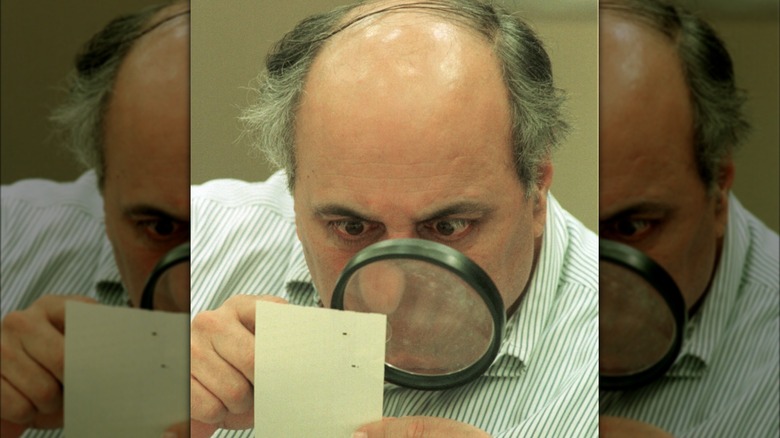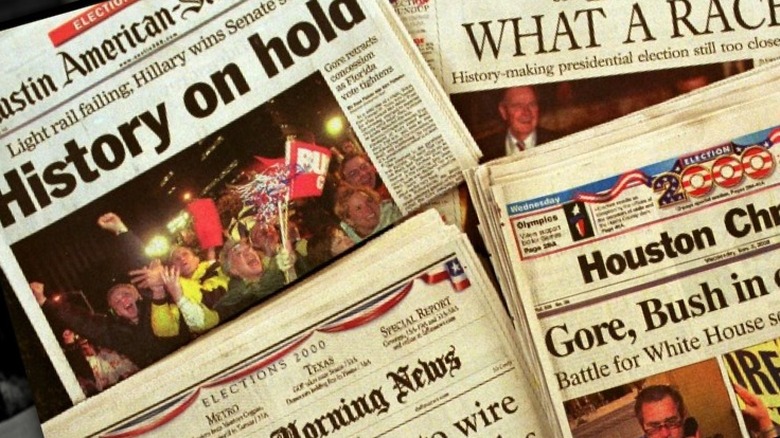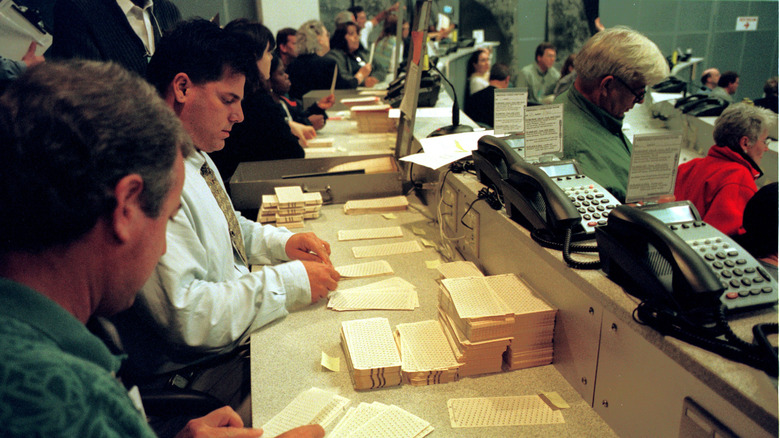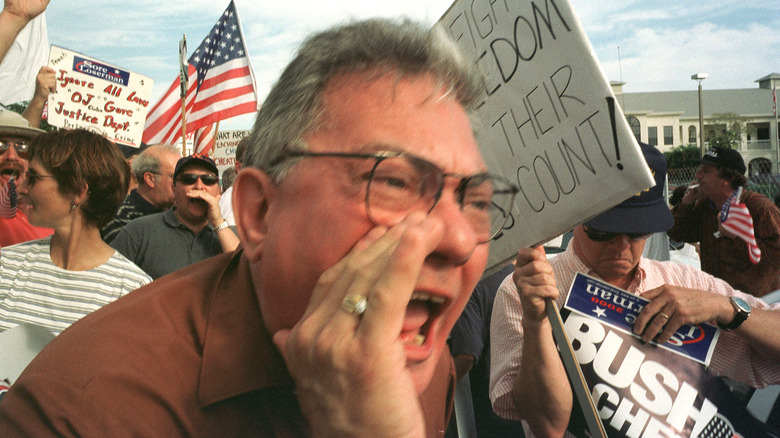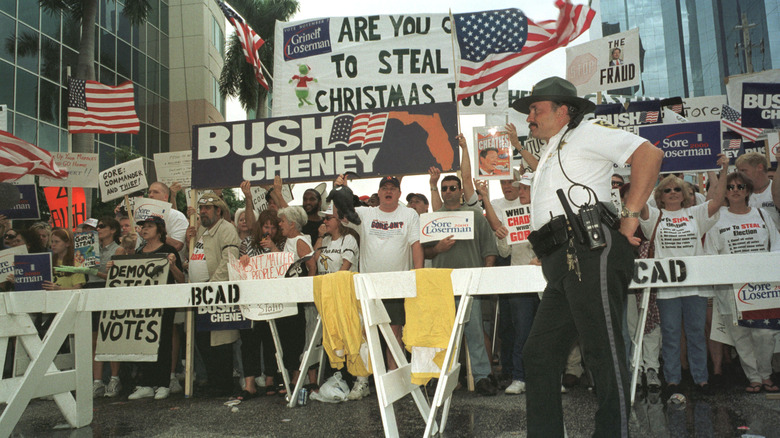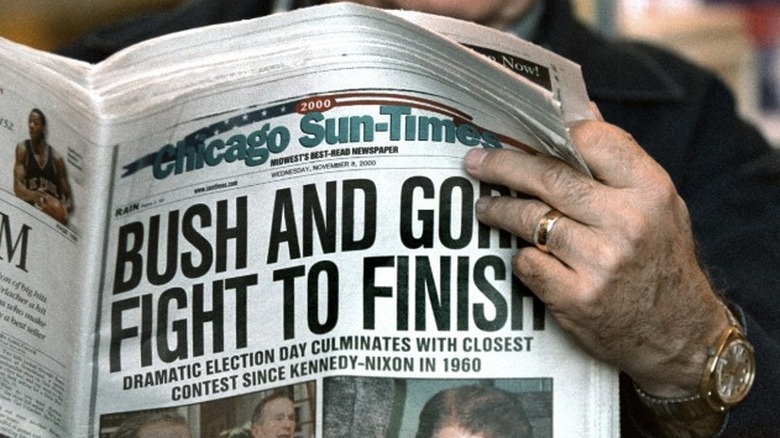The Brooks Brothers Riot Of 2000 Explained
This is the story of how an angry Republican mob stormed a government building and incited a violent riot in an attempt to stop Democrats from allegedly stealing the American presidency. Incited by false rumors of election fraud, they demanded officials stop the count, stop stealing the vote, and stop rigging the system. The riot was orchestrated by political consultant Roger Stone with the sanction of top congressional Republicans, who hoped to intimidate officials, interrupt the machinations of the democratic process, and delegitimize the results of the election overall to swing the outcome in favor of the party's candidate.
No, not the Capitol Riots — the other one. Two decades and three presidents ago, on November 22, 2000, The New York Times, The Washington Post, and CNN reported that a riot of George W. Bush supporters had broken out on the 19th floor of the Stephen P. Clarke Government Building in Miami-Dade County, where officials were conducting a manual recount of disputed ballots from the 2000 presidential election. Dozens of protestors tried to prevent election workers from counting the votes. In a stunning turn of events that may have altered the outcome of the 2000 presidential election, they succeeded — Judge Lawrence King decided Miami-Dade would stop hand-counting ballots.
King ruled officials would count only the undervotes and cut off access to the general public. The controversial decision ignored two stipulations of Florida election law that state if a manual recount finds "an error in the vote tabulation" that could alter the outcome of the election, the county canvassing board would "manually recount all ballots" and "be open to the public." The event was dubbed the Brooks Brothers Riot, and it's one of the oddest forgotten stories in the history of 20th-century American politics.
Butterflies, chads, and the bourgeoise: an American disaster
The 2000 presidential election was the most contentious in over a century of American history. The nation had been in political purgatory for 35 days with still no news on which candidate had won the presidency. At the center of the tumult was the state of Florida, with its 25 electoral votes — enough to swing the outcome in favor of either candidate, as Salon reported at the time. The Florida recount was riddled with issues ranging from "butterfly ballots" (via Associated Press, posted by WFTS) to "hanging chads" (via The Washington Post). Voting machines, and the machinations of America's election system overall, appeared outdated and prone to frequent malfunctioning. After the Florida Supreme Court had ordered statewide recounts, a few highly-contested counties were still struggling and had decided to conduct their recounts by hand, according to The New York Times. Among those was Miami-Dade County, Florida, which was conducting its recount at the Stephen P. Clark Government Center under the supervision of its Canvassing Board.
On November 22, 2000, the Miami-Dade Canvassing Board, after throwing out two days' worth of counting, convened again at the Stephen P. Clark Government Center, with officials scrambling to meet the court-ordered deadline of 5:00 p.m. Sunday evening. With 654,000 votes total and 10,750 rejected by voting machines left to count by hand, they were down to the wire.
'Shut It Down': Sweeney gives the order
The mood at the Stephen P. Clark Government Center was already tense, and according to Bush campaign operative Brad Blakeman (reported in The Washington Post), that was exactly how he wanted it. While Gore fought in the courts to demand recounts in contested counties, Bush tried to stop them while he also waged an ongoing war for public opinion. According to Blakeman, this entailed fomenting an atmosphere of ongoing protest by mobilizing a Republican base with claims of alleged vote fraud, encouraging supporters to gather at recount sites. Such was the scene on the morning all hell broke loose.
The series of events that led to the riot began to unfold when Judge Lawrence King decided election officials would count the remainder of the votes in a smaller room on the 19th floor, reportedly so they could be closer to the vote scanning machine and speed up the process (via The New York Times). The crowd of already-raucous Bush supporters erupted in outrage, believing officials planned to conduct the recount in secret and thereby steal the election for Democrat Al Gore. Once the news broke, Republican John Sweeney (according to Slate and The New Yorker) reportedly turned to an aide and said something akin to, "Shut it down."
Civil unrest in Miami-Dade County
According to Roger Stone in The New Yorker, instigating the Brooks Brothers riot was his idea, and, if one is to believe him, what happened next was coordinated by Republican operatives from the back of a Winnebago. (Republican Brad Blakeman, as The Washington Post reported, claims Stone exaggerated his role — rather than deny Republicans' role in organizing the riot overall, however, Blakeman simply takes credit instead.) Stone said Republican officials set up a mobile headquarters, operating phone banks, coordinating with key players, and communicating with those inside the building via walkie-talkie.
Inside the building, several angry Republicans boarded the elevator, breaking into a sprint as they chased officials up to the 19th floor. A small crowd congregated outside the glass-paneled room where the votes were being counted, hurling insults, threats, and chanting angrily. It didn't take long for dozens more Bush supporters to join them. As the crowd began to swell, the mood grew increasingly unruly. A few supporters began to barrage the door, demanding to be let inside the room (via The Observer).
The 10,000 votes and (not) counting
As congregants attempted to break through the doors to the room where the votes were being counted, it didn't take long for a riot to break out. According to The New York Times, the crowd grew increasingly agitated, the halls grew increasingly crowded, and the scene grew increasingly dangerous (via CNN). Members of the press were knocked to the ground and nearly trampled. Several others were punched or slapped, according to The Washington Post. Democratic chair Joe Geller was assaulted by the crowd, escaping to his car with an escort of 10 sheriff's deputies. Geller said at one point that he feared for his life.
"Let us in!" the crowd chanted, according to The New York Times, while Newsweek remembered their refrain, "Stop counting the votes!" Two hours after the mob dispersed (via The New York Times) amid calls from Republican leaders (who decided things had escalated too far), Miami-Dade officials decided to do exactly that. They stopped counting the votes, claiming they'd never have finished in time, anyway.
Who were the rioters?
Rioters were predominantly white men wearing crisp dress shirts, expensive jackets, and fine watches, a bourgeois wardrobe more reminiscent of Brooks Brothers than beach casual. In fact, the rioters looked a lot like they'd just hopped off a plane from Washington, D.C. as The Washington Post, Salon, and others noted with the bemusement. Perhaps that was because many of them had.
Nearly a dozen Republican staffers and congressional aides were identified among the rioters, according to The Washington Post. Among them was a top aide to Republican Heather Wilson, Marjorie Strayer, who told CNN she had simply stopped by on her way to the Seaquarium. Five rioters were identified as employees of Tom DeLay, the former House Majority Whip and congressional Republican from Texas, as Observer Daily reported. Many of the Brooks Brothers rioters instead went on to hold powerful positions in the Bush administration.
Those votes from Miami-Dade County were never counted. At the time ABC News said the decision could "cripple" Gore's chances of overtaking Bush in the election. "Under Florida law, once the finding is made, the recount is mandatory," the candidate's campaign chairman, Bill Daley, told reporters at the time. Nevertheless, the campaign's legal battle yielded no real results. According to The New York Times, George W. Bush was declared Florida's winner on November 26. Despite losing the popular vote, Bush's 537-vote lead in Florida (out of the state's nearly 6 million votes) secured him Florida's 25 electoral votes, and thereby secured him the presidency.
